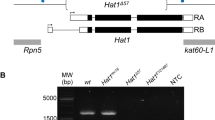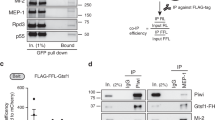Abstract
The establishment and maintenance of mitotic and meiotic stable (epigenetic) transcription patterns is fundamental for cell determination and function1. Epigenetic regulation of transcription is mediated by epigenetic activators and repressors, and may require the establishment, ‘spreading’ and maintenance of epigenetic signals2. Although these signals remain unclear, it has been proposed that chromatin structure and consequently post-translational modification of histones may have an important role in epigenetic gene expression3,4. Here we show that the epigenetic activator Ash1 (ref. 5) is a multi-catalytic histone methyl-transferase (HMTase) that methylates lysine residues 4 and 9 in H3 and 20 in H4. Transcriptional activation by Ash1 coincides with methylation of these three lysine residues at the promoter of Ash1 target genes. The methylation pattern placed by Ash1 may serve as a binding surface for a chromatin remodelling complex containing the epigenetic activator Brahma (Brm)6, an ATPase, and inhibits the interaction of epigenetic repressors with chromatin. Chromatin immunoprecipitation indicates that epigenetic activation of Ultrabithorax transcription in Drosophila coincides with trivalent methylation by Ash1 and recruitment of Brm. Thus, histone methylation by Ash1 may provide a specific signal for the establishment of epigenetic, active transcription patterns.
This is a preview of subscription content, access via your institution
Access options
Subscribe to this journal
Receive 51 print issues and online access
$199.00 per year
only $3.90 per issue
Buy this article
- Purchase on Springer Link
- Instant access to full article PDF
Prices may be subject to local taxes which are calculated during checkout




Similar content being viewed by others
References
Simon, J. A. & Tamkun, J. W. Programming off and on states in chromatin: mechanisms of Polycomb and trithorax group complexes. Curr. Opin. Genet. Dev. 12, 210–218 (2002)
Urnov, F. D. & Wolffe, A. P. Above and within the genome: epigenetics past and present. J. Mammary Gland Biol. Neoplasia 6, 153–167 (2001)
Turner, B. M. Histone acetylation and an epigenetic code. Bioessays 22, 836–845 (2000)
Cavalli, G. & Paro, R. Epigenetic inheritance of active chromatin after removal of the main transactivator. Science 286, 955–958 (1999)
Tripoulas, N. A., Hersperger, E., La Jeunesse, D. & Shearn, A. Molecular genetic analysis of the Drosophila melanogaster gene absent, small or homeotic discs1 (ash1). Genetics 137, 1027–1038 (1994)
Elfring, L. K. et al. Genetic analysis of brahma: the Drosophila homolog of the yeast chromatin remodeling factor SWI2/SNF2. Genetics 148, 251–265 (1998)
Kuo, M. H. & Allis, C. D. Roles of histone acetyltransferases and deacetylases in gene regulation. Bioessays 20, 615–626 (1998)
Pham, A.-D. & Sauer, F. Ubiquitin-activating/conjugating activity of TAFII250, a mediator of activation of gene expression in Drosophila. Science 289, 2357–2360 (2000)
Sun, Z. W. & Allis, C. D. Ubiquitination of histone H2B regulates H3 methylation and gene silencing in yeast. Nature 418, 104–108 (2002)
Zhang, Y. & Reinberg, D. Transcription regulation by histone methylation: interplay between different covalent modifications of the core histone tails. Genes Dev. 15, 2343–2360 (2001)
Stallcup, M. R. Role of protein methylation in chromatin remodeling and transcriptional regulation. Oncogene 20, 3014–3020 (2001)
Rea, S. et al. Regulation of chromatin structure by site-specific histone H3 methyltransferases. Nature 406, 593–599 (2000)
Briggs, S. D. et al. Histone H3 lysine 4 methylation is mediated by Set1 and required for cell growth and rDNA silencing in Saccharomyces cerevisiae. Genes Dev. 15, 3286–3295 (2001)
Nishioka, K. et al. PR-Set7 is a nucleosome-specific methyltransferase that modifies lysine 20 of histone H4 and is associated with silent chromatin. Mol. Cell 9, 1201–1213 (2002)
Nishioka, K. et al. Set9, a novel histone H3 methyltrnsferase that facilitates transcription by precluding histone tail modifications required for heterochromatin formation. Genes Dev. 16, 479–489 (2002)
Strahl, B. D., Ohba, R., Cook, R. G. & Allis, C. D. Methylation of histone H3 at lysine 4 is highly conserved and correlates with transcriptionally active nuclei in Tetrahymena. Proc. Natl Acad. Sci. USA 96, 14967–14972 (1999)
Rozovskaia, T. et al. Trithorax and ASH1 interact directly and associate with the trithorax group-responsive bxd region of the Ultrabithorax promoter. Mol. Cell. Biol. 19, 6441–6447 (1999)
Lillie, J. W. & Green, M. R. Transcription activation by the adenovirus E1a protein. Nature 338, 39–44 (1989)
Rio, D. C. & Rubin, G. M. Transformation of cultured Drosophila melanogaster cells with a dominant selectable marker. Mol. Cell. Biol. 5, 1833–1838 (1985)
Sauer, F. & Jäckle, H. Dimerization and the control of transcription by Krüppel. Nature 364, 454–457 (1993)
Kuo, M. H. & Allis, C. D. In vivo cross-linking and immunoprecipitation for studying dynamic Protein:DNA associations in a chromatin environment. Methods 19, 425–433 (1999)
Bannister, A. J. et al. Selective recognition of methylated lysine 9 on histone H3 by the HP1 chromo domain. Nature 410, 120–124 (2001)
Lachner, M., O'Carroll, D., Rea, S., Mechtler, K. & Jenuwein, T. Methylation of histone H3 lysine 9 creates a binding site for HP1 proteins. Nature 410, 116–120 (2001)
Orlando, V. & Paro, R. Mapping Polycomb-repressed domains in the bithorax complex using in vivo formaldehyde cross-linked chromatin. Cell 75, 1187–1198 (1993)
LaJeunesse, D. & Shearn, A. Trans-regulation of thoracic homeotic selector genes of the Antennapedia and bithorax complexes by the trithorax group genes: absent, small, and homeotic discs 1 and 2. Mech. Dev. 53, 123–139 (1995)
Paro, R. & Hogness, D. S. The Polycomb protein shares a homologous domain with a heterochromatin-associated protein of Drosophila. Proc. Natl Acad. Sci. USA 88, 263–267 (1991)
Ridgway, P. & Almouzni, G. CAF-1 and the inheritance of chromatin states: at the crossroads of DNA replication and repair. J. Cell Sci. 113, 2647–2658 (2000)
Sauer, F., Hansen, S. K. & Tjian, R. DNA template and activator-coactivator requirements for transcriptional synergism by Drosophila Bicoid. Science 270, 1825–1828 (1995)
Acknowledgements
We thank M. Meisterernst for anti-dimethylated H4-K20 antibody; A. Shearn and A. Mazo for fly strains; R. Deuring and J. Tamkun for anti-Brm antibody; S. Schönfelder and R. Paro for Trx cDNA; J. Tyler for p55 cDNA; and various members of the laboratory for critical reading of the manuscript. We are grateful to J. Rami for editorial help and Y. Cully for photowork. This work was supported by a Graduiertenkolleg 484 fellowship (Deutshe Forschungsgemeinschaft) (C.B.) and a Tranregio/Sonderforschungsbereich grant (F.S.).
Author information
Authors and Affiliations
Corresponding author
Ethics declarations
Competing interests
The authors declare that they have no competing financial interests.
Rights and permissions
About this article
Cite this article
Beisel, C., Imhof, A., Greene, J. et al. Histone methylation by the Drosophila epigenetic transcriptional regulator Ash1. Nature 419, 857–862 (2002). https://doi.org/10.1038/nature01126
Received:
Accepted:
Published:
Issue Date:
DOI: https://doi.org/10.1038/nature01126
This article is cited by
-
The Histone Methyltransferase Ash1l is Required for Epidermal Homeostasis in Mice
Scientific Reports (2017)
-
Drosophila Cyclin G and epigenetic maintenance of gene expression during development
Epigenetics & Chromatin (2015)
-
Sound of silence: the properties and functions of repressive Lys methyltransferases
Nature Reviews Molecular Cell Biology (2015)
-
Retraction Note: Histone methylation by the Drosophila epigenetic transcriptional regulator Ash1
Nature (2015)
-
Tau promotes neurodegeneration through global chromatin relaxation
Nature Neuroscience (2014)
Comments
By submitting a comment you agree to abide by our Terms and Community Guidelines. If you find something abusive or that does not comply with our terms or guidelines please flag it as inappropriate.



